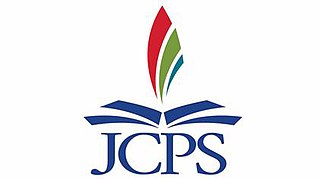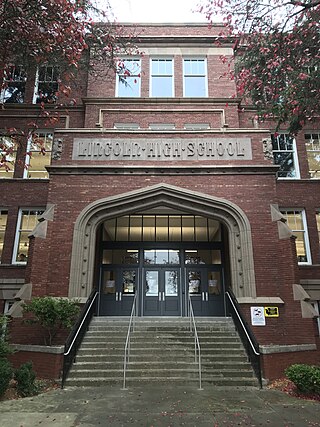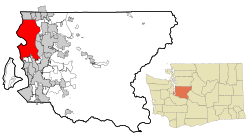
Denny Park is a park located in the South Lake Union neighborhood of Seattle, Washington. It occupies the block bounded by John Street and Denny Way on the north and south and Dexter and 9th Avenues N. on the west and east.

Jefferson County Public Schools (JCPS) is a public school district located in Jefferson County, Kentucky, and operating all but one of the public schools in the county. It is governed by an elected seven-member Board of Education, which selects and hires a superintendent, who serves as the system's chief executive.
The Washington Assessment of Student Learning (WASL) was a standardized educational assessment system given as the primary assessment in the state of Washington from spring 1997 to summer 2009. The WASL was also used as a high school graduation examination beginning in the spring of 2006 and ending in 2009. It has been replaced by the High School Proficiency Exam (HSPE), the Measurements of Students Progress (MSP) for grades 3–8, and later the Smarter Balanced Assessment (SBAC). The WASL assessment consisted of examinations over four subjects with four different types of questions. It was given to students from third through eighth grades and tenth grade. Third and sixth graders were tested in reading and math; fourth and seventh graders in math, reading and writing. Fifth and eighth graders were tested in reading, math and science. The high school assessment, given during a student's tenth grade year, contained all four subjects.

Kamiakin High School is a public high school in Kennewick, Washington, the second of three comprehensive high schools in the Kennewick School District. Kamiakin opened in the fall of 1970 and serves the district's northwest portion. The school colors are scarlet and gold and the mascot is the Braves.

James A. Garfield High School is a public high school in the Seattle Public Schools district of Seattle, Washington. It is named after James A. Garfield, the 20th President of the United States. The school is located at 400 23rd Avenue between E. Alder and E. Jefferson Streets in the Central District section of Seattle.

Franklin High School is a public high school in Seattle, Washington, located in its Mount Baker neighborhood and administered by Seattle Public Schools.

Chief Sealth International High School (CSIHS) is a public high school in the Seattle Public Schools district of Seattle, Washington. Opened in 1957 in southern West Seattle, Chief Sealth students comprise one of the most ethnically and culturally diverse student bodies in Washington State. The school is named for Chief Seattle, a Duwamish chief and a recognized leader amongst the local peoples at the time of the arrival of European American settlers in the area. The school shares a campus with Denny International Middle School (DIMS).
The Garfield Public Schools is a comprehensive community public school district that serves students in pre-Kindergarten through twelfth grade from Garfield, in Bergen County, in the U.S. state of New Jersey. The district is one of 31 former Abbott districts statewide that were established pursuant to the decision by the New Jersey Supreme Court in Abbott v. Burke which are now referred to as "SDA Districts" based on the requirement for the state to cover all costs for school building and renovation projects in these districts under the supervision of the New Jersey Schools Development Authority.

Port Townsend High School is located in Port Townsend, Washington. It is one of the oldest in Washington State, graduating its first class in 1891. Port Townsend High School is a comprehensive public high school, serving approximately 350 students in grades 9-12 in 2018, and is fully approved and accredited by the State of Washington and the Northwest Commission on Colleges and Universities.
Mukilteo School District No. 6 is a public school district that mainly serves Mukilteo, Washington. The Mukilteo School District includes all of the city, but also a portion of south Everett, Lynnwood, and Edmonds. The district had more than 14,600 students in 2013–14 and a budget of approximately $147 million.

Tyee High School, formerly Tyee Educational Complex, is a public high school campus located in SeaTac, Washington, United States. It was founded as Tyee High School, a single public high school, in 1962. It is operated by the Highline School District.

Tahoma High School (THS) is a public high school serving grades nine through twelve, and is the only high school in the Tahoma School District. The school provides for citizens in southeast King County, and has been housed in multiple buildings, the current one being a three-story structure in Maple Valley built in 2017.

Frank B. Cooper Elementary School, usually called Cooper School, serves students from kindergarten through 5th grade. Located in the Pigeon Point neighborhood of Delridge, Seattle, Washington, it is part of the Seattle Public Schools district. The school's 14-acre (57,000 m2) site is immediately adjacent to the 182-acre (0.74 km2) West Duwamish Greenbelt, one of Seattle's largest wildlife habitat corridors. This rich natural environment enhances the school's environmental education program.

Denny International Middle School (DIMS) is a middle school in West Seattle, the southwest portion of Seattle, Washington. Operated by Seattle Public Schools. It is named for David T. Denny, one of Seattle’s early settlers and an early member of the Seattle School Board. The school shares a campus with Chief Sealth International High School (CSIHS) which together provide a joint facility for students in grades 6-12. The school's student population is racially and culturally diverse and the programs offered reflect this.

Reginald Heber Thomson was a self-taught American civil engineer. He worked in Washington state, mainly in Seattle, where he became city engineer in 1892 and held the position for two decades. Alan J. Stein wrote that Thomson "probably did more than any other individual to change the face of Seattle" and was responsible for "virtually all of Seattle's infrastructure".
Aki Kurose Middle School is a public secondary school in Seattle, Washington, part of the Seattle Public Schools. Located in the Rainier Valley in southeast Seattle, it serves students in grades 6-8. The school is one of the most racially diverse schools in Seattle, with 97% of its student body being of color. A high proportion of its students are also recent immigrants, and 42% of the students are non-English speakers. The school emphasizes development of relationships between the community and the school, and establishing respect between students and teachers.

Lincoln High School is a public high school in Seattle, Washington, part of the Seattle Public Schools district and named after Abraham Lincoln, the 16th President of the United States.
Toppenish School District No. 202 is a public school district in Toppenish, Washington, United States. It serves the city of Toppenish, the surrounding areas in Yakima County, and members of the nearby Yakima Nation.
Steilacoom Historical School District No. 1 is a public school district in Steilacoom, Washington, United States. It serves the city of Steilacoom, the communities of DuPont and Anderson Island, and portions of Lakewood and unincorporated Pierce County.


























